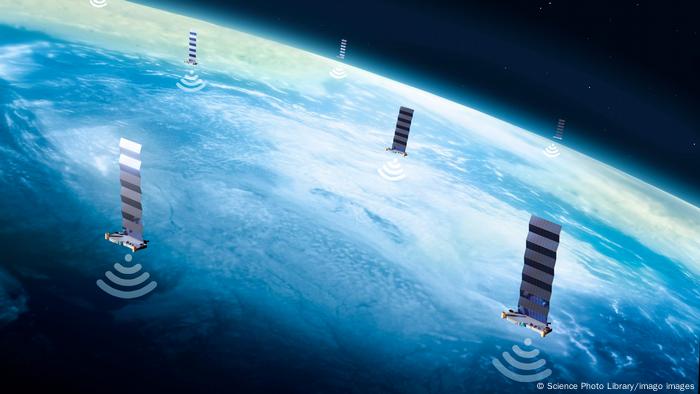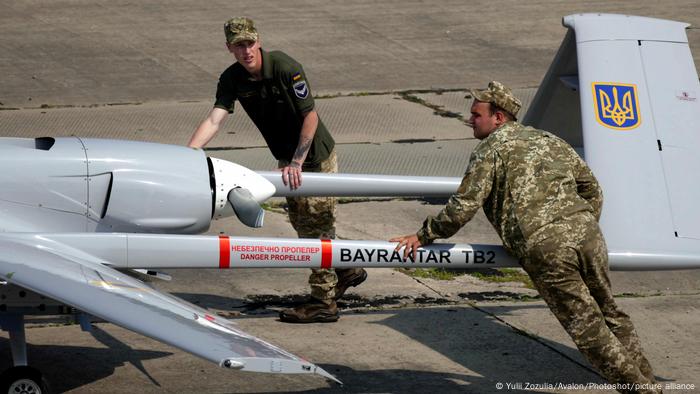Elon Musk's satellites are connecting Ukraine with the internet. Starlink was conceived as a civilian program — but Ukraine's military can also use it to guide drones and strike Russian tanks and positions.

Just after Russia's invasion began, Ukrainian Vice Prime Minister Mykhailo Fedorov took to Twitter to ask the Texas businessman Elon Musk to activate his Starlink satellites for use in Ukraine. The billionaire swiftly tweeted his response: "Starlink service is now active in Ukraine. More terminals en route."
Soon after, a number of terminals and powerful batteries arrived in Ukraine. Others followed. Fedorov took to Twitter again to express his gratitude: "Starlink — here. Thanks, @elonmusk."
No secret dispatches, no long debates, no governmental or parliamentary controls: just a very public deal between a politician whose country has been attacked and an enigmatic billionaire who went on to challenge the aggressor, Russian President Vladimir Putin, to "single combat." What at first looked like a PR coup now seems to be playing a significant role in the defense of Ukraine.
'Create target acquisition'
British media report that Ukraine's army is making very successful use of Starlink for drone attacks on Russian tanks and positions. The Telegraph reports that Starlink is of particular military significance in areas where the infrastructure is weak and there is no Internet connection.
According to Telegraph, the aerial reconnaissance unit Aerorozvidka is using Starlink to monitor and coordinate unmanned aerial vehicles (UAVs), enabling soldiers to fire anti-tank weapons with targeted precision. Only the system's high data rates can provide the stable communication required, The Telegraph reports.
An officer with the Aerorozvidka unit described the system to Times of London. "We use Starlink equipment and connect the drone team with our artillery team," he said. "If we use a drone with thermal vision at night, the drone must connect through Starlink to the artillery guy and create target acquisition."
The Times reports that the Aerorozvidka team runs about 300 information-gathering missions each day. Attacks are then carried out at night, according to the newspaper, because the drones, some of which are equipped with thermal cameras, are almost impossible to see in the dark.
British media report that Ukraine's army is making very successful use of Starlink for drone attacks on Russian tanks and positions. The Telegraph reports that Starlink is of particular military significance in areas where the infrastructure is weak and there is no Internet connection.
According to Telegraph, the aerial reconnaissance unit Aerorozvidka is using Starlink to monitor and coordinate unmanned aerial vehicles (UAVs), enabling soldiers to fire anti-tank weapons with targeted precision. Only the system's high data rates can provide the stable communication required, The Telegraph reports.
An officer with the Aerorozvidka unit described the system to Times of London. "We use Starlink equipment and connect the drone team with our artillery team," he said. "If we use a drone with thermal vision at night, the drone must connect through Starlink to the artillery guy and create target acquisition."
The Times reports that the Aerorozvidka team runs about 300 information-gathering missions each day. Attacks are then carried out at night, according to the newspaper, because the drones, some of which are equipped with thermal cameras, are almost impossible to see in the dark.
Many possible uses
Starlink satellites are intended to provide internet to undersupplied regions far from urban centers. The potential for using satellites to get information to people in regions where the internet is censored had been discussed. Few, however, had imagined that its initial use would be in a European war zone in which one of the aggressor's first acts at the start of the invasion was to target and destroy power supplies and internet connections.
Ukrainians have — or have regained — access to information. According to The Telegraph, Starlink is one of the most popular app downloads in Ukraine, enabling more than 100,000 people to stay updated about what is happening in the war, and to keep in touch with the outside world.
Ukrainian President Volodymyr Zelenskyy uses the Starlink satellites to make speeches to the nation and to national parliaments around the world. Quite apart from its military usefulness, Starlink has become vital to Ukraine, both for obtaining worldwide support and for maintaining the unbroken resistance of the people.
Target for Russia?
As Russia will keep trying to target and destroy Ukrainian infrastructure, including power and internet, the connection will likely be even more important in the coming weeks and months. This, of course, also means that the Starlink reception dishes, which are not exactly inconspicuous, will be targets for Russian troops.
The biggest danger, however, is that the reception equipment can be geolocated while in operation. Shortly after the first terminals were delivered in early March, Musk tweeted: "Turn on Starlink only when needed and place antenna as far away from people as possible."
In addition to targeted attacks, Russia is apparently also trying to use jammers to block internet access from space. But SpaceX says it already has a solution: On Twitter, Musk wrote that a new software update lowers power consumption and can bypass jamming transmitters.
The Kremlin considers Musk's support of Ukraine an aggression. Dmitry Olegovich Rogozin, the head of the Russian space agency, Roskosmos, called Starlink's activities interference. "When Russia implements its highest national interests on the territory of Ukraine, Elon Musk appears with his Starlink, which was previously declared purely civilian," he said on RT.
Musk's response was as laconic as ever. "Ukraine civilian Internet was experiencing strange outages - bad weather perhaps? - so SpaceX is helping fix it," he tweeted.
This article was originally written in German.

UKRAINE'S CIVILIANS PROVIDE SUPPORT FOR THE WAR EFFORT
Anti-tank obstacles instead of sculptures
In peacetime, artist Volodymyr Kolesnykov creates metal sculptures in his workshop in Uzhhorod, near the Hungarian border. These days, his time is spent welding anti-tank obstacles, or "Czech hedgehogs," along with other artists and metalworkers.
123456
Starlink satellites are intended to provide internet to undersupplied regions far from urban centers. The potential for using satellites to get information to people in regions where the internet is censored had been discussed. Few, however, had imagined that its initial use would be in a European war zone in which one of the aggressor's first acts at the start of the invasion was to target and destroy power supplies and internet connections.
Ukrainians have — or have regained — access to information. According to The Telegraph, Starlink is one of the most popular app downloads in Ukraine, enabling more than 100,000 people to stay updated about what is happening in the war, and to keep in touch with the outside world.
Ukrainian President Volodymyr Zelenskyy uses the Starlink satellites to make speeches to the nation and to national parliaments around the world. Quite apart from its military usefulness, Starlink has become vital to Ukraine, both for obtaining worldwide support and for maintaining the unbroken resistance of the people.
Target for Russia?
As Russia will keep trying to target and destroy Ukrainian infrastructure, including power and internet, the connection will likely be even more important in the coming weeks and months. This, of course, also means that the Starlink reception dishes, which are not exactly inconspicuous, will be targets for Russian troops.
The biggest danger, however, is that the reception equipment can be geolocated while in operation. Shortly after the first terminals were delivered in early March, Musk tweeted: "Turn on Starlink only when needed and place antenna as far away from people as possible."
In addition to targeted attacks, Russia is apparently also trying to use jammers to block internet access from space. But SpaceX says it already has a solution: On Twitter, Musk wrote that a new software update lowers power consumption and can bypass jamming transmitters.
The Kremlin considers Musk's support of Ukraine an aggression. Dmitry Olegovich Rogozin, the head of the Russian space agency, Roskosmos, called Starlink's activities interference. "When Russia implements its highest national interests on the territory of Ukraine, Elon Musk appears with his Starlink, which was previously declared purely civilian," he said on RT.
Musk's response was as laconic as ever. "Ukraine civilian Internet was experiencing strange outages - bad weather perhaps? - so SpaceX is helping fix it," he tweeted.
This article was originally written in German.

UKRAINE'S CIVILIANS PROVIDE SUPPORT FOR THE WAR EFFORT
Anti-tank obstacles instead of sculptures
In peacetime, artist Volodymyr Kolesnykov creates metal sculptures in his workshop in Uzhhorod, near the Hungarian border. These days, his time is spent welding anti-tank obstacles, or "Czech hedgehogs," along with other artists and metalworkers.
123456


No comments:
Post a Comment